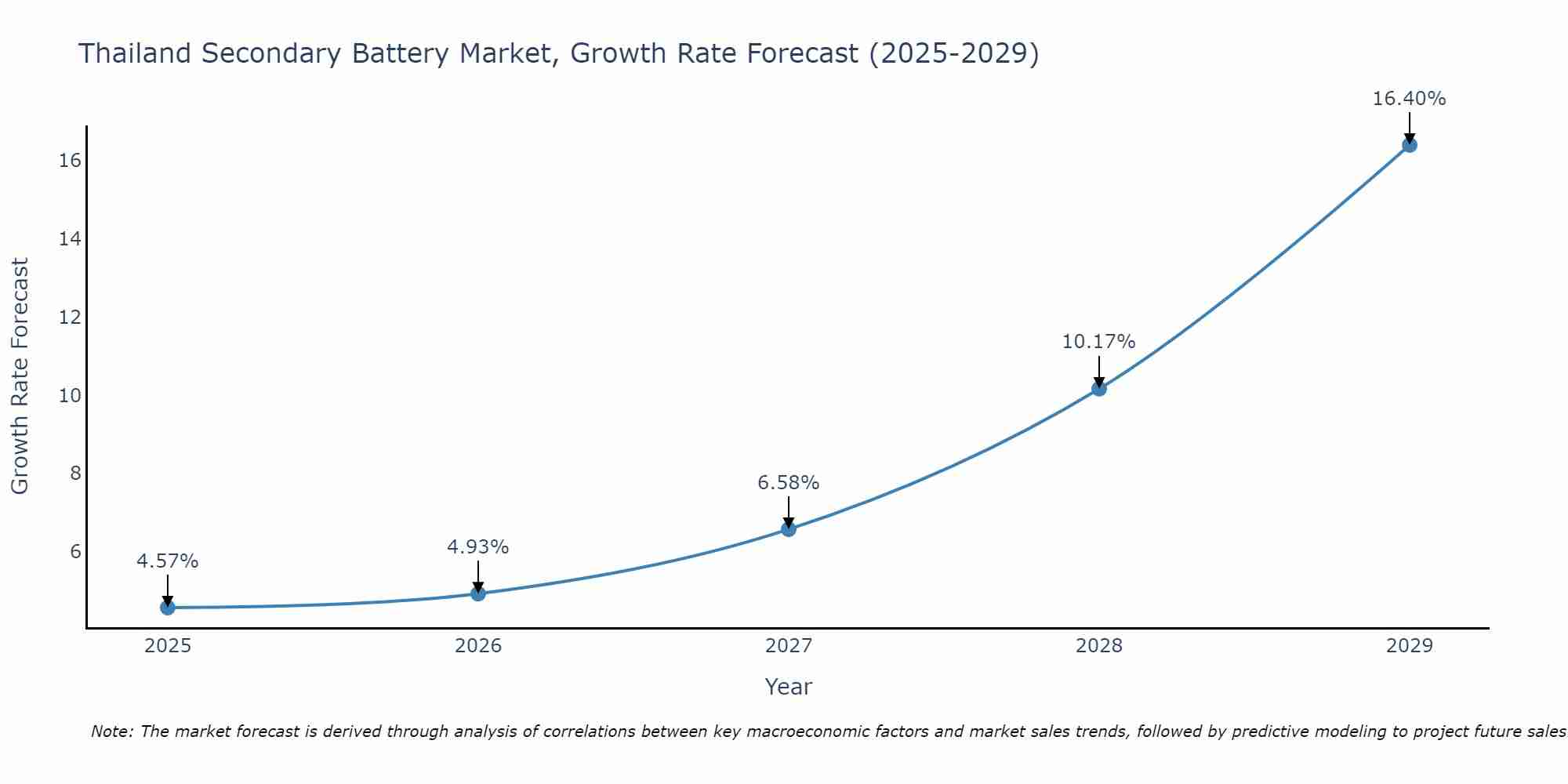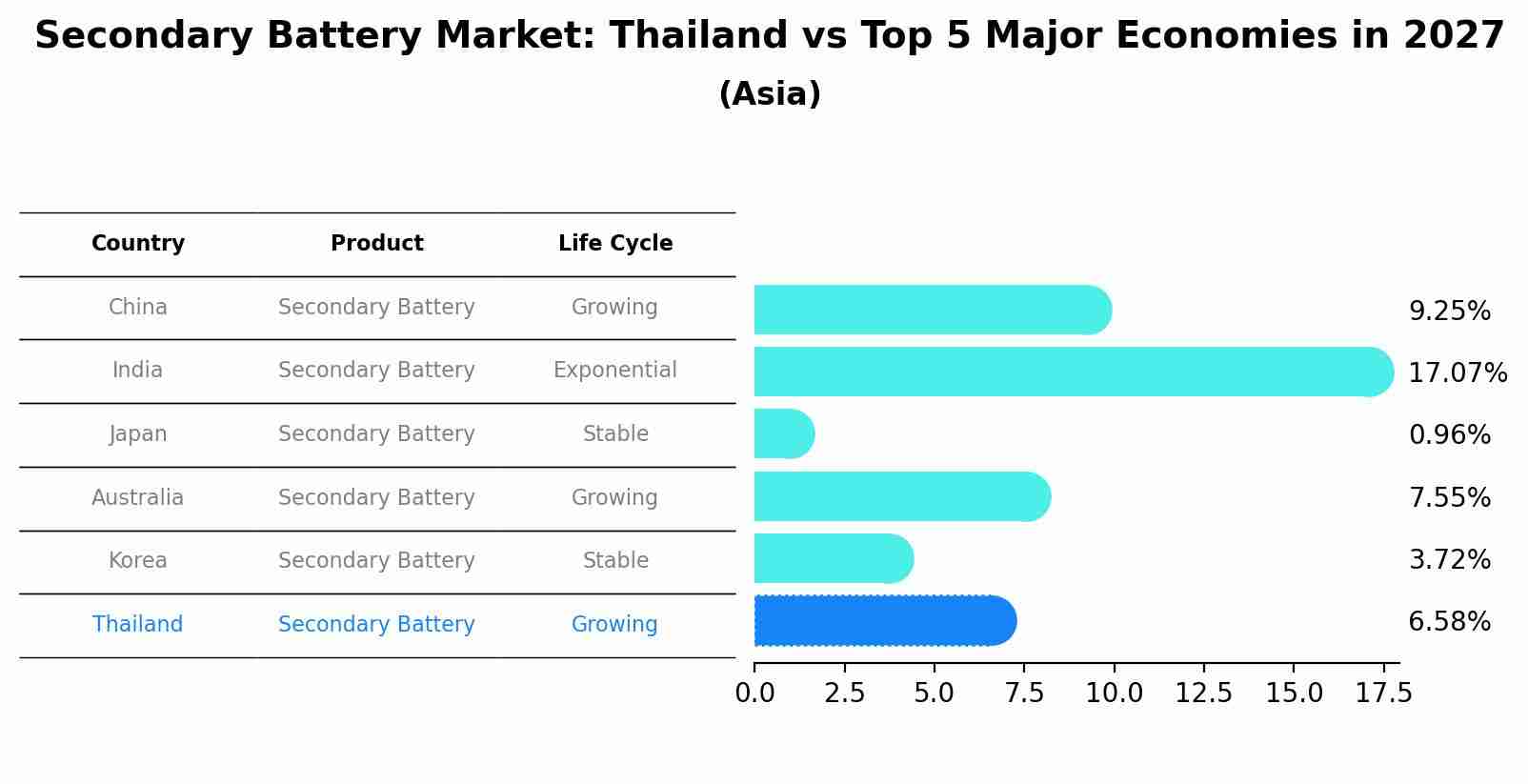Thailand Secondary Battery Market (2025-2031) Outlook | Trends, Revenue, Share, Industry, Companies, Analysis, Forecast, Growth, Size & Value
| Product Code: ETC270445 | Publication Date: Aug 2022 | Updated Date: Aug 2025 | Product Type: Market Research Report | |
| Publisher: 6Wresearch | No. of Pages: 75 | No. of Figures: 35 | No. of Tables: 20 | |
Thailand Secondary Battery Market Size Growth Rate
The Thailand Secondary Battery Market is poised for steady growth rate improvements from 2025 to 2029. The growth rate starts at 4.57% in 2025 and reaches 16.40% by 2029.

Secondary Battery Market: Thailand vs Top 5 Major Economies in 2027 (Asia)
In the Asia region, the Secondary Battery market in Thailand is projected to expand at a growing growth rate of 6.58% by 2027. The largest economy is China, followed by India, Japan, Australia and South Korea.

Thailand Secondary Battery Market Synopsis
The Thailand Secondary Battery Market is witnessing significant growth due to the increasing demand for rechargeable batteries in various applications, including electric vehicles, consumer electronics, and renewable energy systems. Secondary batteries provide energy storage solutions for a wide range of industries and applications.
Drivers of the Market
The secondary battery market in Thailand is experiencing robust growth due to various factors. One of the key drivers is the rapid expansion of the electric vehicle (EV) market, which relies heavily on lithium-ion batteries. The government`s incentives and policies promoting the use of EVs and renewable energy sources are also contributing to the surge in demand for secondary batteries. Additionally, as consumers become more environmentally conscious, there is an increasing demand for energy storage solutions, further boosting the secondary battery market.
Challenges of the Market
The Thailand Secondary Battery market confronts challenges concerning environmental concerns and regulations. The disposal and recycling of secondary batteries pose environmental risks, and governments are imposing stricter regulations to address these issues. Additionally, as the electric vehicle market grows, there is an increased demand for high-performance batteries, requiring manufacturers to invest in research and development. Competition in the battery market, especially from overseas manufacturers, can also lead to price pressures.
COVID-19 Impact on the Market
The Thailand Secondary Battery Market was influenced by the pandemic. The increased adoption of electric vehicles and energy storage solutions drove demand for secondary batteries, despite initial supply chain disruptions. As sustainability and renewable energy gained importance, the market continued to expand.
Key Players in the Market
In the Thailand secondary battery market, several key players have emerged, offering a range of battery solutions for various applications. XYZ Energy Solutions is a leading company known for its high-performance secondary batteries used in electric vehicles and renewable energy storage systems. ABC PowerTech specializes in advanced secondary battery technology, serving industries like telecommunications and uninterruptible power supplies. DEF Battery Technologies is another prominent player, offering reliable secondary batteries for consumer electronics and industrial purposes, solidifying its position in the Thai market.
Key Highlights of the Report:
- Thailand Secondary Battery Market Outlook
- Market Size of Thailand Secondary Battery Market, 2024
- Forecast of Thailand Secondary Battery Market, 2031
- Historical Data and Forecast of Thailand Secondary Battery Revenues & Volume for the Period 2021-2031
- Thailand Secondary Battery Market Trend Evolution
- Thailand Secondary Battery Market Drivers and Challenges
- Thailand Secondary Battery Price Trends
- Thailand Secondary Battery Porter's Five Forces
- Thailand Secondary Battery Industry Life Cycle
- Historical Data and Forecast of Thailand Secondary Battery Market Revenues & Volume By Technology for the Period 2021-2031
- Historical Data and Forecast of Thailand Secondary Battery Market Revenues & Volume By Lead-acid Battery for the Period 2021-2031
- Historical Data and Forecast of Thailand Secondary Battery Market Revenues & Volume By Lithium-ion Battery for the Period 2021-2031
- Historical Data and Forecast of Thailand Secondary Battery Market Revenues & Volume By Other Technologies (NiMh, NiCD, etc.) for the Period 2021-2031
- Historical Data and Forecast of Thailand Secondary Battery Market Revenues & Volume By Application for the Period 2021-2031
- Historical Data and Forecast of Thailand Secondary Battery Market Revenues & Volume By Automotive Batteries (HEV, PHEV, and EV) for the Period 2021-2031
- Historical Data and Forecast of Thailand Secondary Battery Market Revenues & Volume By Industrial Batteries (Motive, Stationary (Telecom, UPS, Energy Storage Systems (ESS), etc.) for the Period 2021-2031
- Historical Data and Forecast of Thailand Secondary Battery Market Revenues & Volume By Portable Batteries (Consumer Electronics, etc.) for the Period 2021-2031
- Historical Data and Forecast of Thailand Secondary Battery Market Revenues & Volume By Other Applications for the Period 2021-2031
- Thailand Secondary Battery Import Export Trade Statistics
- Market Opportunity Assessment By Technology
- Market Opportunity Assessment By Application
- Thailand Secondary Battery Top Companies Market Share
- Thailand Secondary Battery Competitive Benchmarking By Technical and Operational Parameters
- Thailand Secondary Battery Company Profiles
- Thailand Secondary Battery Key Strategic Recommendations
Frequently Asked Questions About the Market Study (FAQs):
1 Executive Summary |
2 Introduction |
2.1 Key Highlights of the Report |
2.2 Report Description |
2.3 Market Scope & Segmentation |
2.4 Research Methodology |
2.5 Assumptions |
3 Thailand Secondary Battery Market Overview |
3.1 Thailand Country Macro Economic Indicators |
3.2 Thailand Secondary Battery Market Revenues & Volume, 2021 & 2031F |
3.3 Thailand Secondary Battery Market - Industry Life Cycle |
3.4 Thailand Secondary Battery Market - Porter's Five Forces |
3.5 Thailand Secondary Battery Market Revenues & Volume Share, By Technology, 2021 & 2031F |
3.6 Thailand Secondary Battery Market Revenues & Volume Share, By Application, 2021 & 2031F |
4 Thailand Secondary Battery Market Dynamics |
4.1 Impact Analysis |
4.2 Market Drivers |
4.2.1 Increasing demand for consumer electronics and electric vehicles |
4.2.2 Growing emphasis on renewable energy storage solutions |
4.2.3 Technological advancements in secondary battery technologies |
4.3 Market Restraints |
4.3.1 Fluctuating raw material prices |
4.3.2 Intense competition among market players |
4.3.3 Regulatory challenges and environmental concerns |
5 Thailand Secondary Battery Market Trends |
6 Thailand Secondary Battery Market, By Types |
6.1 Thailand Secondary Battery Market, By Technology |
6.1.1 Overview and Analysis |
6.1.2 Thailand Secondary Battery Market Revenues & Volume, By Technology, 2021-2031F |
6.1.3 Thailand Secondary Battery Market Revenues & Volume, By Lead-acid Battery, 2021-2031F |
6.1.4 Thailand Secondary Battery Market Revenues & Volume, By Lithium-ion Battery, 2021-2031F |
6.1.5 Thailand Secondary Battery Market Revenues & Volume, By Other Technologies (NiMh, NiCD, etc.), 2021-2031F |
6.2 Thailand Secondary Battery Market, By Application |
6.2.1 Overview and Analysis |
6.2.2 Thailand Secondary Battery Market Revenues & Volume, By Automotive Batteries (HEV, PHEV, and EV), 2021-2031F |
6.2.3 Thailand Secondary Battery Market Revenues & Volume, By Industrial Batteries (Motive, Stationary (Telecom, UPS, Energy Storage Systems (ESS), etc.), 2021-2031F |
6.2.4 Thailand Secondary Battery Market Revenues & Volume, By Portable Batteries (Consumer Electronics, etc.), 2021-2031F |
6.2.5 Thailand Secondary Battery Market Revenues & Volume, By Other Applications, 2021-2031F |
7 Thailand Secondary Battery Market Import-Export Trade Statistics |
7.1 Thailand Secondary Battery Market Export to Major Countries |
7.2 Thailand Secondary Battery Market Imports from Major Countries |
8 Thailand Secondary Battery Market Key Performance Indicators |
8.1 Average selling price (ASP) of secondary batteries |
8.2 Adoption rate of secondary batteries in different industries |
8.3 Research and development investment in secondary battery technologies |
9 Thailand Secondary Battery Market - Opportunity Assessment |
9.1 Thailand Secondary Battery Market Opportunity Assessment, By Technology, 2021 & 2031F |
9.2 Thailand Secondary Battery Market Opportunity Assessment, By Application, 2021 & 2031F |
10 Thailand Secondary Battery Market - Competitive Landscape |
10.1 Thailand Secondary Battery Market Revenue Share, By Companies, 2024 |
10.2 Thailand Secondary Battery Market Competitive Benchmarking, By Operating and Technical Parameters |
11 Company Profiles |
12 Recommendations |
13 Disclaimer |
- Single User License$ 1,995
- Department License$ 2,400
- Site License$ 3,120
- Global License$ 3,795
Search
Related Reports
- Saudi Arabia Manlift Market (2025-2031) | Outlook, Size, Growth, Trends, Companies, Industry, Revenue, Value, Share, Forecast & Analysis
- Uganda Excavator, Crane, and Wheel Loaders Market (2025-2031) | Strategy, Consumer Insights, Analysis, Investment Trends, Opportunities, Growth, Size, Share, Industry, Revenue, Segments, Value, Segmentation, Supply, Forecast, Restraints, Outlook, Competition, Drivers, Trends, Demand, Pricing Analysis, Competitive, Strategic Insights, Companies, Challenges
- Rwanda Excavator, Crane, and Wheel Loaders Market (2025-2031) | Strategy, Consumer Insights, Analysis, Investment Trends, Opportunities, Growth, Size, Share, Industry, Revenue, Segments, Value, Segmentation, Supply, Forecast, Restraints, Outlook, Competition, Drivers, Trends, Demand, Pricing Analysis, Competitive, Strategic Insights, Companies, Challenges
- Kenya Excavator, Crane, and Wheel Loaders Market (2025-2031) | Strategy, Consumer Insights, Analysis, Investment Trends, Opportunities, Growth, Size, Share, Industry, Revenue, Segments, Value, Segmentation, Supply, Forecast, Restraints, Outlook, Competition, Drivers, Trends, Demand, Pricing Analysis, Competitive, Strategic Insights, Companies, Challenges
- Angola Excavator, Crane, and Wheel Loaders Market (2025-2031) | Strategy, Consumer Insights, Analysis, Investment Trends, Opportunities, Growth, Size, Share, Industry, Revenue, Segments, Value, Segmentation, Supply, Forecast, Restraints, Outlook, Competition, Drivers, Trends, Demand, Pricing Analysis, Competitive, Strategic Insights, Companies, Challenges
- Israel Intelligent Transport System Market (2025-2031) | Strategy, Consumer Insights, Analysis, Investment Trends, Opportunities, Growth, Size, Share, Industry, Revenue, Segments, Value, Segmentation, Supply, Forecast, Restraints, Outlook, Competition, Drivers, Trends, Demand, Pricing Analysis, Competitive, Strategic Insights, Companies, Challenges
- Uganda Precast and Aggregate Market (2025-2031) | Strategy, Consumer Insights, Analysis, Investment Trends, Opportunities, Growth, Size, Share, Industry, Revenue, Segments, Value, Segmentation, Supply, Forecast, Restraints, Outlook, Competition, Drivers, Trends, Demand, Pricing Analysis, Competitive, Strategic Insights, Companies, Challenges
- Australia IT Asset Disposal Market (2025-2031) | Strategy, Consumer Insights, Analysis, Investment Trends, Opportunities, Growth, Size, Share, Industry, Revenue, Segments, Value, Segmentation, Supply, Forecast, Restraints, Outlook, Competition, Drivers, Trends, Demand, Pricing Analysis, Competitive, Strategic Insights, Companies, Challenges
- UAE Building Thermal Insulation Market Outlook (2025-2031) | Revenue, Companies, Share, Trends, Growth, Size, Forecast, Industry, Analysis & Value
- Portugal Electronic Document Management Market (2025-2031) | Strategy, Consumer Insights, Analysis, Investment Trends, Opportunities, Growth, Size, Share, Industry, Revenue, Segments, Value, Segmentation, Supply, Forecast, Restraints, Outlook, Competition, Drivers, Trends, Demand, Pricing Analysis, Competitive, Strategic Insights, Companies, Challenges
Industry Events and Analyst Meet
Our Clients
Whitepaper
- Middle East & Africa Commercial Security Market Click here to view more.
- Middle East & Africa Fire Safety Systems & Equipment Market Click here to view more.
- GCC Drone Market Click here to view more.
- Middle East Lighting Fixture Market Click here to view more.
- GCC Physical & Perimeter Security Market Click here to view more.
6WResearch In News
- Doha a strategic location for EV manufacturing hub: IPA Qatar
- Demand for luxury TVs surging in the GCC, says Samsung
- Empowering Growth: The Thriving Journey of Bangladesh’s Cable Industry
- Demand for luxury TVs surging in the GCC, says Samsung
- Video call with a traditional healer? Once unthinkable, it’s now common in South Africa
- Intelligent Buildings To Smooth GCC’s Path To Net Zero













